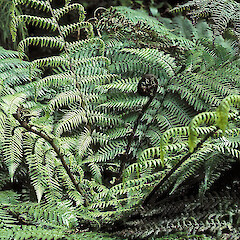Dicksonia squarrosa
Common name
wheki, rough tree fern, harsh tree fern
Synonyms
Trichomanes squarrosum G.Forst., Dicksonia gracilis Colenso; Dicksonia squarrosa var. gracilis (Colenso) C.Chr.; Balantium squarrosum (G.Forst.) Kunze;
Family
Dicksoniaceae
Flora category
Vascular – Native
Endemic taxon
Yes
Endemic genus
No
Endemic family
No
Structural class
Ferns
NVS code
The National Vegetation Survey (NVS) Databank is a physical archive and electronic databank containing records of over 94,000 vegetation survey plots - including data from over 19,000 permanent plots. NVS maintains a standard set of species code abbreviations that correspond to standard scientific plant names from the Ngä Tipu o Aotearoa - New Zealand Plants database.
DICSQU
Chromosome number
2n = 130
Current conservation status
The conservation status of all known New Zealand vascular plant taxa at the rank of species and below were reassessed in 2017 using the New Zealand Threat Classification System (NZTCS) – more information about this can be found on the NZTCS website. This report includes a statistical summary and brief notes on changes since 2012 and replaces all previous NZTCS lists for vascular plants.
Please note, threat classifications are often suggested by authors when publications fall between NZTCS assessment periods – an interim threat classification status has not been assessed by the NZTCS panel.
- Conservation status of New Zealand indigenous vascular plants, 2017 . 2018. Peter J. de Lange, Jeremy R. Rolfe, John W. Barkla, Shannel P. Courtney, Paul D. Champion, Leon R. Perrie, Sarah M. Beadel, Kerry A. Ford, Ilse Breitwieser, Ines Schönberger, Rowan Hindmarsh-Walls, Peter B. Heenan and Kate Ladley. Department of Conservation. Source: NZTCS and licensed by DOC for reuse under the Creative Commons Attribution 4.0 International licence.
2017 | Not Threatened
Previous conservation statuses
2012 | Not Threatened
2009 | Not Threatened
2004 | Not Threatened
Brief description
Tree fern up to 8 m tall. Usually forming colonies. Trunks covered in dead, black stipe ends, not dense, and often bearing aerial buds. Live fronds often untidy and tattered, usually falling when dead, or forming an irregular, messy skirt.
Distribution
Endemic. New Zealand: North Island, South Island, Stewart Island/Rakiura, Chatham Islands.
Wetland plant indicator status rating
Information derived from the revised national wetland plant list prepared to assist councils in delineating and monitoring wetlands (Clarkson et al., 2021 Manaaki Whenua – Landcare Research Contract Report LC3975 for Hawke’s Bay Regional Council). The national plant list categorises plants by the extent to which they are found in wetlands and not ‘drylands’. The indicator status ratings are OBL (obligate wetland), FACW (facultative wetland), FAC (facultative), FACU (facultative upland), and UPL (obligate upland). If you have suggestions for the Wetland Indicator Status Rating, please contact: [Enable JavaScript to view protected content]
FACU: Facultative Upland
Occasionally is a hydrophyte but usually occurs in uplands (non-wetlands).
Detailed description
Tree ferns up to 8 m tall. Rhizomatous usually forming colonial stands. Rhizomes numerous spreading from main stock 1–2 m or more distant, giving rise to subsidiary erect caudices. Trunk slender, solitary, bifurcated (sometimes several times over), up to c. 200 mm diam., composed of long-persistent, black stipe bases, interwoven dark brown to black rootlets, red-brown hairs and dormant or active aerial buds. Fronds numerous, persistent or not in death, either falling or forming an untidy, tattered skirt (especially on young plants); in life erect, arching, forming an often tattered, untidy crown, 1.0–2.0–(2.6) m long, 0.5–1.0 m wide. Stipes (180)–280–300–(320) mm long, black, ± rugose, base densely clad deciduous dark red-brown to brown filiform hairs 30–40–(55) mm long; rachises initially clad in dark reddish brown hairs when young, becoming rugose with age. Lamina (0.68)–1.6–(2.28) m long, oblong-lanceolate, (2)–3–4-pinnate, adaxially light to dark glossy green, abaxially paler, harshly coriaceous; primary pinnae 250–500 mm long, deltoid-ovate to lanceolate, acuminate; secondary pinnae close-set to ± overlapping, 50–80 mm long, acute. Barren pinnules 10–18 mm, acute, often sharply toothed, widened and confluent at base, shallowly concave; fertile pinnules close-set, narrowly confluent at base, 10–15 mm long; lobes strongly concavo-convex c. 5 mm. long, rounded, each bearing a sorus. Sorus ± rounded, terminating veins at fertile pinnae margins; sporangia on raised receptacle, partially obscured by in rolled pinnae margin, and delicate, submembranous inner indusium. Spores golden brown to red-brown.
Similar taxa
Dicksonia squarrosa is easily recognised by the rhizomatous growth habit; the plants forming interconnected colonial stands of tree ferns up to 7 m tall and with slender trunks, up to 200 mm diameter. The trunks of this species are not dense, and are made up of persistent, dead, black stipe bases, interwoven with dark brown to black rootlets, and bearing aerial buds. The dead fronds of D. squarrosa are not persistent, or if so, they form an untidy skirt. The fresh stipes of this species are distinctly rough to the touch.
Propagation technique
Easily grown from fresh spores, by division of plantlets and by transplanting the mature trunks. Tolerant of a wide range of situations and soil types. Dicksonia squarrosa needs room to spread and can become aggressive in some garden situations. This species often naturally appears in garden situations.
Etymology
dicksonia: After James Dickson (1738-1822), British botanist and nuseryman
squarrosa: Rough, with scale-like projections; from the Latin squarrosus; leaves and leaf stalks
Where To Buy
Commonly available from mainstream and specialist native plant nurseries.
Attribution
Fact Sheet Prepared for NZPCN by P.J. de Lange (10 November 2012). Description by P.J. de Lange.
NZPCN Fact Sheet citation
Please cite as: de Lange, P.J. (Year at time of access): Dicksonia squarrosa Fact Sheet (content continuously updated). New Zealand Plant Conservation Network. https://www.nzpcn.org.nz/flora/species/dicksonia-squarrosa/ (Date website was queried)

















